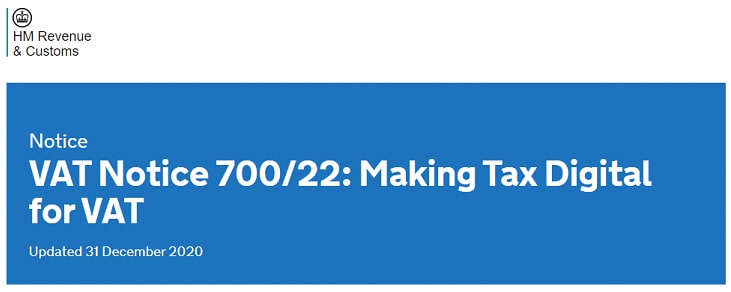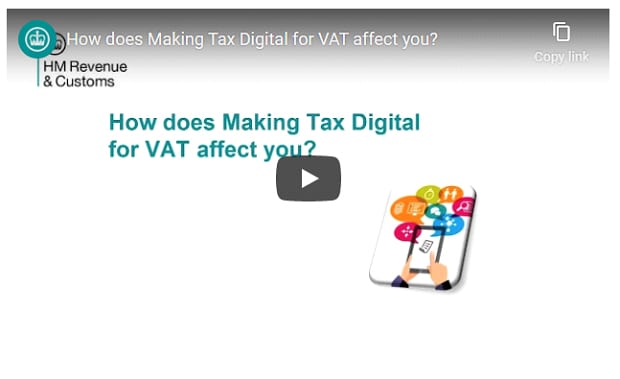From the 1 April 2022, MTD for VAT will apply to all VAT registered businesses regardless of the level of turnover. The first VAT period to which MTD applies to all VAT registered businesses (who are not already doing so) will be the one commencing on or after 1 April 2022.
What is “Making Tax Digital”?Making Tax Digital (MTD) is a government initiative to modernise HMRC’s tax system, with the aim of making the whole process of administrating tax simpler and more efficient. All of your tax information will be in one place (your digital account) and you will be able to pay tax based on your business activity during the year. You can upload and update your tax account in real time.
Will it affect me?If you own a business, you are self-employed and you pay income tax, national insurance, VAT or corporation tax, then it is quite likely you will be affected. This means you could be required to keep track of your tax affairs digitally using MTD compatible software, and to update HMRC at least quarterly via your digital tax account. Eventually this will abolish the annual tax return. This will be the law and there will be penalties for non- compliance.
When is all this happening?MTD for VAT has already started and has been “live” for nearly two years. It started with businesses above the VAT threshold limits (currently £85,000) in April 2019.
From the 1 April 2022, MTD for VAT will apply to all VAT registered businesses regardless of level of turnover.
This notice below explains the rules for Making Tax Digital for VAT and about the digital information you must keep if they apply to you. It was last updated 31 December 2020.
Please talk to us about how we can help your business comply with the new rules. We can recommend the right software and provide the training and support you need.
VAT notice 700/22: Making Tax Digital (MTD) for VATThis notice explains the rules for Making Tax Digital for VAT and about the digital information you must keep if they apply to you. It was last updated 31 December 2020.

Rules introduced under the Making Tax Digital (MTD) initiative mean VAT registered businesses with taxable turnover above the VAT registration threshold need to keep digital records and submit VAT Returns to HMRC using compatible software. From 1 April 2022 this will apply to all VAT registered businesses.
This notice explains:
- the digital records businesses must keep, and ways to record transactions digitally in certain special circumstances
- what counts as compatible software, and when software programs do and do not need to be digitally linked where a combination of programs is used.
MTD for VAT requires VAT registered businesses with taxable turnover above the VAT registration threshold to keep records in digital form and file their VAT Returns using software.
It is increasingly common for business records and accounts to be kept digitally, in a software program on a computer or tablet, or in a smartphone application, or maintained through such a device and stored using a cloud-based application.
The difference under MTD is that the software which businesses use must be capable of keeping and maintaining the records specified in the regulations, preparing their VAT Returns using the information maintained in those digital records and communicating with HMRC digitally through the Application Programming Interface (API) platform.
If your digital records are up to date, software will be able to collate and prepare your return for you. It will then show the return to you and ask you to declare that it is correct and confirm that you want to submit it to HMRC. Once you have submitted your return you will receive confirmation through your software that it has been received.
The notice provides further details of the Making Tax Digital rules. The overview of MTD can be seen here:
https://www.gov.uk/government/publications/making-tax-digital/overview-of-making-tax-digital
Government ResourcesBelow are useful references to guidance provided by the Government.
VAT record keeping
VAT registered businesses with a taxable turnover of more than £85,000 must follow the rules for ‘Making Tax Digital for VAT’ by keeping some records digitally, unless:
- your business uses the VAT GIANT service, for example if you’re a government department or an NHS Trust
- you apply for an exemption
You can choose to sign up to Making Tax Digital for VAT if your business earns less than £85,000.
From 1 April 2022 all VAT registered businesses must sign up, whatever they earn.
Records you must keep digitally
- You need to keep the following records digitally:
- your business name, address and VAT registration number
- any VAT accounting schemes you use
- the VAT on goods and services you supply, for example everything you sell, lease, transfer or hire out (supplies made)
- the VAT on goods and services you receive, for example everything you buy, lease, rent or hire (supplies received)
- any adjustments you make to a return
- the ‘time of supply’ and ‘value of supply’ (value excluding VAT) for everything you buy and sell
- the rate of VAT charged on goods and services you supply
- reverse charge transactions – where you record the VAT on both the sale price and the purchase price of goods and services you buy
- your total daily gross takings if you use a retail scheme
- items you can reclaim VAT on if you use the Flat Rate Scheme
- your total sales, and the VAT on those sales, if you trade in gold and use the Gold Accounting Scheme
You also need to keep digital copies of documents that cover multiple transactions made on behalf of your business by:
- volunteers for charity fundraising
- a third-party business
- employees for expenses in petty cash
You must add all your transactions to your digital records, but you do not need to scan paper records like invoices or receipts.
- How to keep digital records
- using formulas to link cells in spreadsheets
- emailing records
- putting records on a portable device to give to your agent
- importing and exporting XML and CSV files
- downloading and uploading files
- a compatible software package that allows you to keep digital records and submit VAT Returns
- bridging software to connect non-compatible software (like spreadsheets) to HMRC systems
- If you use an agent or accountant, talk to them about what software you need.
- your taxable turnover has not been above £85,000 since April 2019
- you’re already exempt from filing VAT Returns online
- you or your business are subject to an insolvency procedure
- of your age, a disability or where you live
- you object to using computers on religious grounds
- of any other reason why it’s not reasonable or practical
- How Making Tax Digital for VAT affects your business
- Getting ready for Making Tax Digital
- Getting compatible accounting software
- Keeping VAT records digitally
- Agent services and Making Tax Digital
- Signing up for Making Tax Digital for VAT
- Making Tax Digital for Income Tax Self-Assessment
You need to use a compatible software package or other software (like spreadsheets) that connect to HMRC systems.
If you use more than one software package to keep records and submit returns, you need to link them.
Some ways you can link your software include:
You must have links between the software you use by your first VAT period after 1 April 2021.
The deadlines for sending your VAT returns will not change after you sign up for Making Tax Digital for VAT.
See: https://www.gov.uk/vat-record-keeping/making-tax-digital-for-vat
Making Tax Digital for VAT as a business: step by step
Follow these steps if you’re a business or sole trader and you need to follow the rules for Making Tax Digital for VAT.
See: https://www.gov.uk/guidance/making-tax-digital-for-vat
Find software that’s compatible with Making Tax Digital for VAT
Before you sign up to Making Tax Digital for VAT you will need either:

See: https://www.gov.uk/guidance/find-software-thats-compatible-with-making-tax-digital-for-vat
Check if you can apply for an exemption or opt out from Making Tax Digital for VAT.
You are automatically exempt from Making Tax Digital for VAT and do not need to apply if:
You can still sign up voluntarily.
Apply for an exemption
You can apply if it’s not reasonable or practical for you to use computers, software or the internet to follow the rules for Making Tax Digital for VAT.
This could be because:
HMRC will consider each application on a case-by-case basis.
See: https://www.gov.uk/guidance/apply-for-an-exemption-from-making-tax-digital-for-vat
Watch webinars and videos for help with Making Tax Digital for VAT

Contents
See: https://www.gov.uk/guidance/help-and-support-for-making-tax-digital
